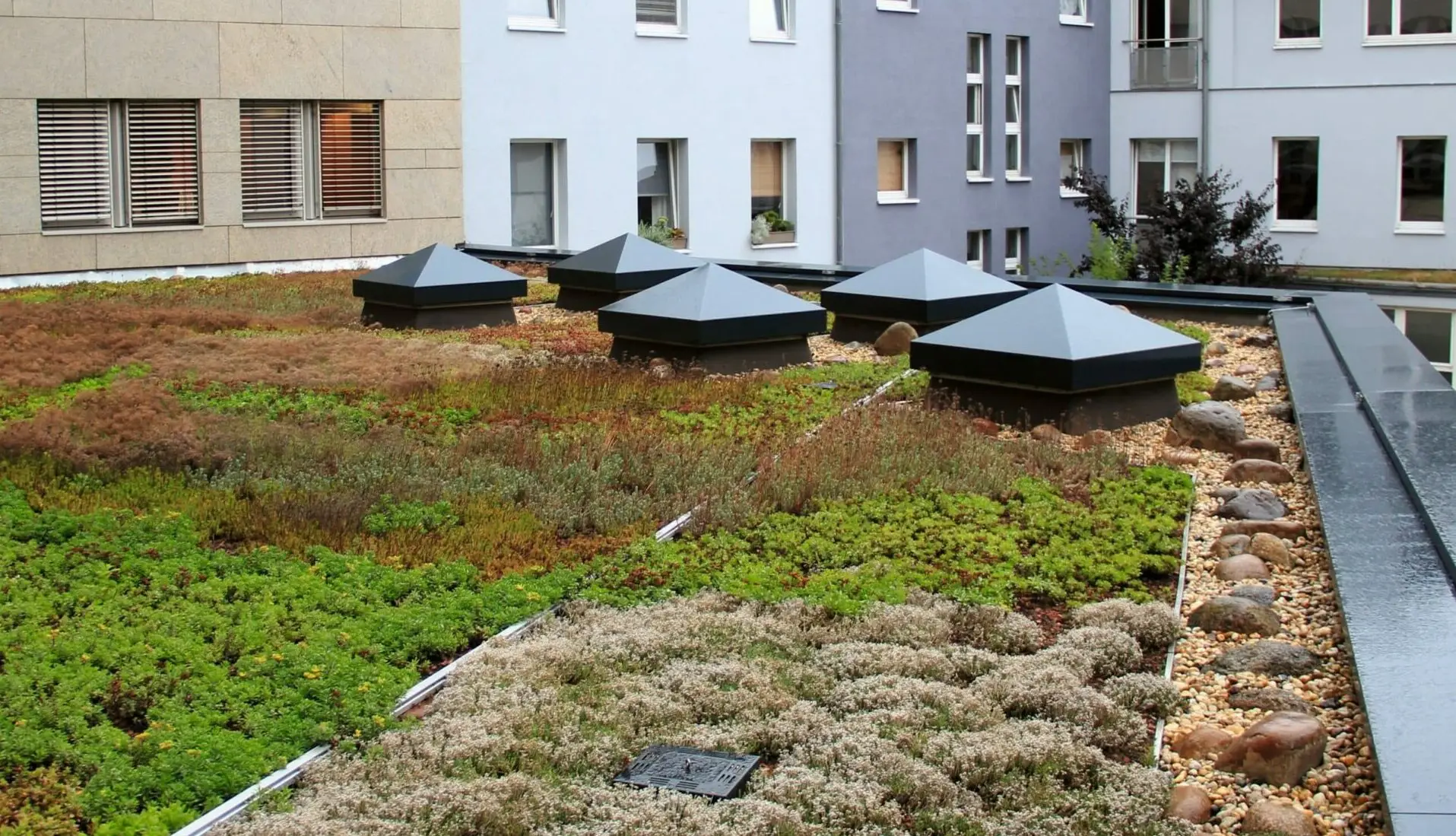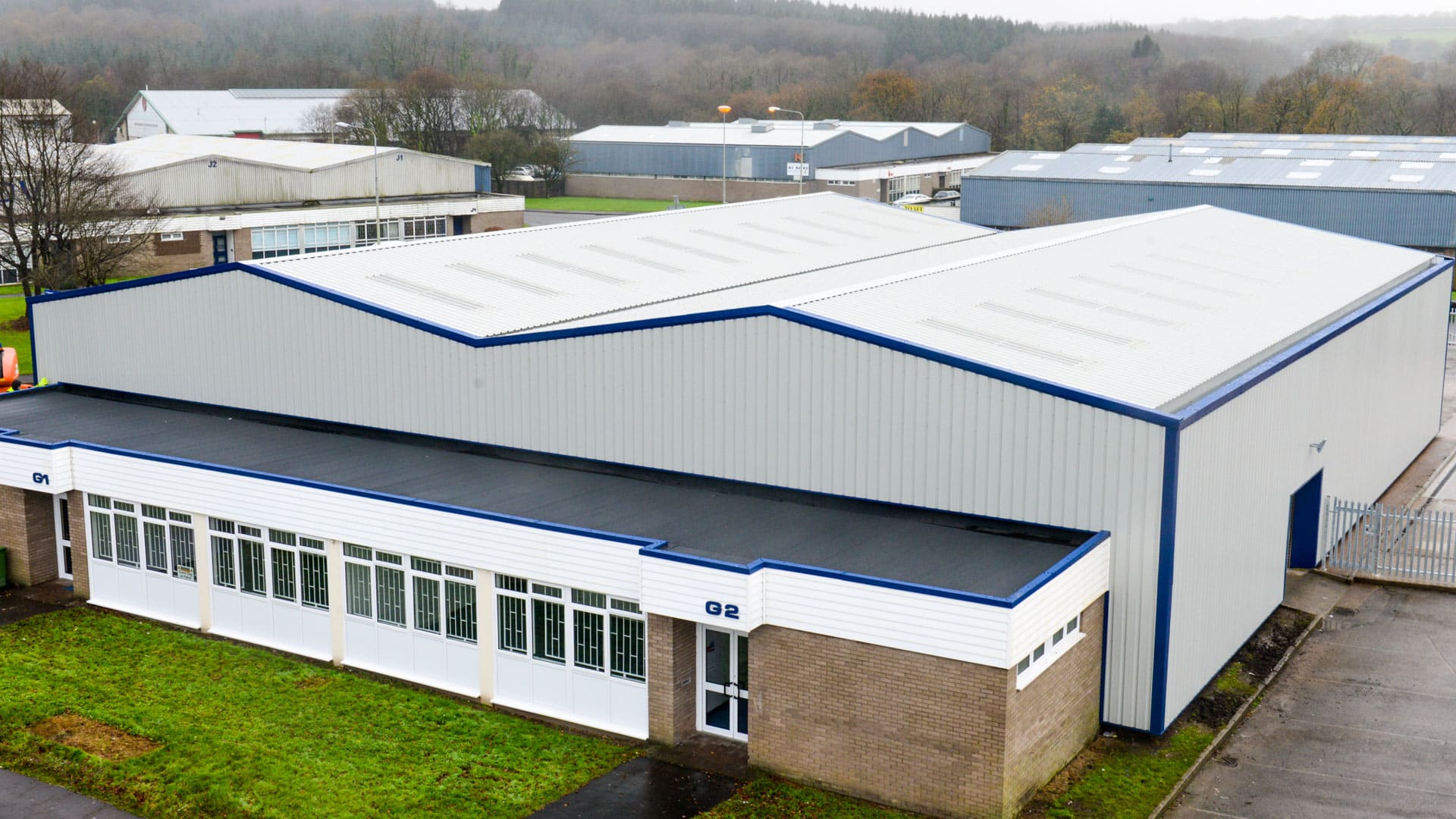

Initiatives for sustainable roofing are now more prevalent than ever before. The UK has now committed to achieving Net-Zero carbon by 2050 across all sectors of the economy. The built environment currently accounts for almost 40% of total carbon emissions and, as such, is one of the areas where the most positive change can occur. However, Net-Zero cannot be achieved through new-build projects alone. Approximately 70% of the UK’s non-residential building stock was constructed before 2000 and will still be in use by 2050. As such, retrofitting must bring these buildings up to Net-Zero standards.
There has been increasing demand for sustainable buildings from occupiers, encouraging investors to respond to this market pressure and increasing government regulations. Sustainable commercial buildings, therefore, help to avoid ‘brown discount’ and typically create a ‘green premium’, increasing the value of the building asset. Whilst Net-Zero has a considerable impact on many commercial businesses, the regulatory framework is being phased in over time to allow businesses time to get up to speed.
However, many public sector organisations already require a strict application of Net-Zero targets immediately. The NHS, for example, has already implemented this policy and is aiming for an ambitious 80% reduction in emissions by 2028-2032 and complete Net-Zero by 2040.
The UK is seen as one of the leaders in Net-Zero Carbon, and there is a significant opportunity to export our knowledge and learning globally, once we have developed scalable solutions. Garland UK always consider sustainable roofing design, whole life carbon, embodied and operational carbon on all client projects, whilst continuing to look at innovative materials and construction methods to make our roofing solutions even more sustainable in the future.
Sustainable Initiatives
It is essential that sustainable roofing initiatives are included in both new-build projects, and any improvement works carried out on existing building assets. The UK is committed to Net-Zero Carbon emissions by 2050, a 68% reduction by 2030 and a 78% reduction by 2035.
Already policies and legislation are starting to come through that will help to achieve these targets. As of 15 June 2022, major changes to the Building Regulations have come into effect. A new Approved Document O (overheating in buildings) has been introduced as well as major updates to Part L (fuel and power) and Part F (ventilation). These changes now mandate that non-domestic buildings must now achieve an average of 27% reduction in carbon emissions relative to the 2013 regulations and domestic buildings must achieve a 30% reduction. This will be followed in 2025 by introducing the Future Homes and Building Standard, which is expected to increase this carbon reduction to around 75%.
To help implement a carbon reduction strategy for a construction project, it is best to conduct a Whole Life Carbon Assessment (WLCA), with a guiding principle to reduce, reuse and recycle. With this in mind, the following sustainable roofing strategies should be considered for carbon emission reduction:
- Assess the need for a new building and the options for repurposing existing assets. The priority at the end of life stage should be to reuse buildings where possible.
- Considering the design of a new building to minimise both operational and embodied carbon emissions. By reducing the quantity of material used while maximising operational efficiency, reducing waste, and enabling building-use adaptability can all help to achieve this.
- Optimising the materials and products used and their associated whole life emissions.
- Minimising the distance travelled by materials and products.
Planners are increasingly requiring that renewable energy sources be included in construction projects as another effective way of reducing carbon emissions. Usually, the most efficient way of complying with this is the installation of photovoltaic systems on your roofing structure.
A complete review of supply chains from top to bottom will highlight where additional carbon emission reductions can occur. This can also ensure that all stages uphold human and labour rights whilst allowing an opportunity for the promotion and adoption of sustainable environmental practices.
Roofing Sustainable Initiatives
Minimum Energy Efficiency Saving Standard
The Minimum Energy Efficiency Saving Standard (MEES) was introduced in March 2015. Since April 2018, to be allowed to renew or grant new tenancies, landlords have been required to ensure their buildings achieve an Energy Performance Certificate (EPC) rating of E. However, MEES is progressing further, from 01 April 2023, it will also apply to existing tenancies. Furthermore, the Government’s December 2020 energy white paper states the intention to raise this standard to an EPC rating of B by 2030. Improved roof insulation can play a huge role in helping your building improve its thermal efficiency and achieve this standard.
Environmental Product Declarations
Environmental Product Declarations (EPD) have been around since 1998 and provide a standardised way to quantify the environmental performance of products. It is a transparent and verified system that ensures products are reviewed over their entire lifecycle. This provides an invaluable tool to help specifiers choose long-life and sustainable roofing products from the supply chain.
Public Sector Decarbonisation
Incentivising the rapid adoption of these sustainable initiatives are the Governments Net Zero Strategy: Build Back Greener (2021) supported by the Public Sector Decarbonisation Scheme, which provides grants for public sector bodies to fund heat decarbonisation and energy efficiency measures. The Phase 1 and 2 are already completed and have already provided more than £1 billion in grants. Phase 3 will provide an additional £1.425 billion over the financial years 2022/2023 to 2024/2025, with the next application window starting in September 2022. Green roofs, roofing insulations and Solar are all essential to achieving these goals. With this significant funding behind it, the transition from desire to action is now happening.

Your roofing project can make a significant difference
Roofing projects provide a vital opportunity for a significant reduction in the overall carbon emissions of your building through reductions in Embodied Carbon, Operational Carbon and reductions in carbon at the End of Life phase of your roof. Our Technical Managers can help you choose the right sustainable solution for your roofing needs.
Embodied Carbon
The most effective way of decreasing embodied carbon emissions is to choose a roofing system with a long lifespan, that should outlast its guarantee. Compared with shorter life products, which of course would need replacing much sooner, this greatly reduces the carbon required to produce the system. Typically, buildings are designed to last for about 60 years, so the closer you can get to achieving this the better. Additionally, where possible you should also specify a roofing system that both uses recycled materials and is itself recyclable to again reduce the embodied carbon of the system.
By conducting thorough condition reports of your existing roofing structure, it is easy to avoid unnecessarily removing the existing deck or insulation whilst conducting any refurbishment or repairs, minimising the amount of new materials needed to restore your roof, and thus reducing its carbon emissions. A moisture mapping survey in particular can help to identify very specific areas of water ingress, so that these areas can be targeted exclusively for repair.
Roof encapsulation solutions should also be seriously considered when a complete roof replacement is necessary. This allows the existing roofing structure to remain in place whilst providing a new waterproofing system This of course eliminates the need for the existing roof to go to landfill, not only saving you the disposal costs but again further reducing the embodied carbon emissions as a result.
Operational Carbon
There are a number of opportunities that your roofing solution can help to reduce the operational carbon of the whole building. Photovoltaic Solar Panels can be incorporated on your roofing system to provide renewable energy, that can be used to reduce the energy consumption of the building.
Green roofs are another very effective way of reducing the operational carbon of your building, by improving thermal efficiency, whilst also actively capturing carbon dioxide through the vegetation that it incorporates.
Finally roofing projects allow for increased insulation to be applied, which again will improve the thermal efficiency of the building, requiring less heating and cooling and thus improving the overall energy efficiency of the structure.
End of Life Carbon Reduction
The End of Life phase of the Whole Carbon Life Cycle should also be considered as it can provide more opportunities to reduce carbon emissions. It is essential to partner with both a manufacturer and approved contractors that encourage mindful waste management, mitigating the need for landfill disposal wherever possible.
It is possible to specify a roofing system that is 100% recyclable at the end of its usable life. Metal roofs, such as our R-MER range are a perfect example of this. Recycled metals produce as much as 90% less carbon when compared with metals processed from ore.

Carbon Accounting
To be able to assess the carbon footprint of your building accurately, it is important to complete a carbon baseline report. From this, the improvements you make by installing PV panels and green roofs, for example, can identify the improvements made and the operational carbon savings documented. Both BREEAM and LEED encourage the use of Life Cycle Costing to help to quantify these variables and asses the sustainability of your project, whilst providing you with accurate long-term costings and savings.
Again, to have the most accurate data for use in Carbon Accounting for your project, and know which sustainable roofing measures to pursue further, your manufacturer roofing partner must be able to provide you with data that complies with the Greenhouse Gas Protocol, the world’s most widely-used greenhouse gas accounting standard. Data must be provided for both Scope 1 (direct emissions from owned/controlled sources) and Scope 2 (indirect emissions from their own use of electricity/ heating etc).
Long-Term Benefits
Hopefully, this article has helped to illustrate how your roof can help you achieve your sustainability objectives. There are two general points that should always be kept in mind when choosing the right solution for your roofing needs.
Firstly, quantifiable results should be provided by your manufacturing partner. We always advise our clients to research and ask questions about environmental claims being made about building materials, as unfortunately, greenwashing can be prevalent in the industry. In some cases, the sustainable credentials are diluted, circumstantial, or may not be relevant to your projects. Always check the Technical Data Sheets in detail to avoid falling for these misrepresentations.
Secondly, to ensure your roofing project supports your sustainability initiatives, do not look at the short-term cost; look at the long-term goals and benefits this will entail. This also often leads to real long-term cost savings. For example, photovoltaic systems can see an ROI in as little as 5 years.
Garland UK’s Technical Managers have a wealth of experience providing roofing solutions that will cut the carbon emissions of your building, helping you to achieve your sustainability goals.
“Roofing projects provide a perfect opportunity to improve the sustainability of your whole building, helping to fulfil legislative requirements whilst providing added value to your building assets.”
Daniel Sandell, Technical Manager, Garland UK
